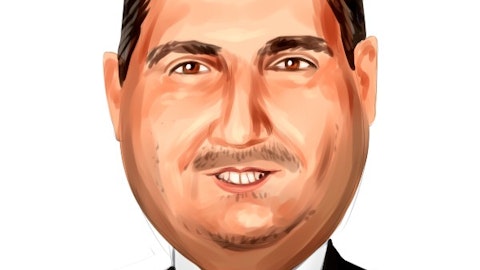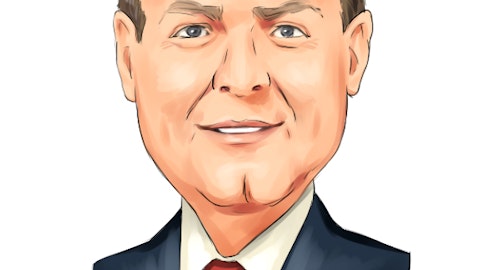Ameris Bancorp (NASDAQ:ABCB) Q3 2023 Earnings Call Transcript October 27, 2023
Operator: Good morning, everyone, and welcome to Ameris Bancorp’s Third Quarter Conference Call. All participants will be in a listen-only mode. [Operator Instructions] After today’s presentation, there will be an opportunity to ask questions. [Operator Instructions] Please also note today’s event is being recorded. At this time, I’d like to turn the floor over to Nicole Stokes, Chief Financial Officer. Ma’am, please go ahead.
Nicole Stokes: Great. Thank you, Jamie, and thank you to all who have joined our call today. During the call, we will be referencing the press release and the financial highlights that are available on the Investor Relations section of our website at amerisbank.com. I’m joined today by Palmer Proctor, our CEO; and Jon Edwards, our Chief Credit Officer. Palmer will begin with some opening general comments, and then I’m going to discuss the details of our financial results before we open it up for Q&A. But before we begin, I’ll remind you that our comments may include forward-looking statements. These statements are subject to risks and uncertainties. The actual results could vary materially. We list some of the factors that might cause results to differ in our press release and in our SEC filings, which are available on our website.
We do not assume any obligation to update any forward-looking statements as a result of new information, early developments or otherwise, except as required by law. Also during the call, we will discuss certain non-GAAP financial measures in reference to the company’s performance. You can see our reconciliation of these measures and GAAP financial measures in the appendix to our presentation. And with that, I’ll turn it over to Palmer for his comments.
Palmer Proctor: Thank you, Nicole, and good morning, everyone. I appreciate you taking the time to join our call today. I am proud to talk about our solid third quarter financial results that we reported yesterday. This quarter really was a testament to our discipline and core profitability, and it’s what creates the positive outlook we have for the future. So for the third quarter, we reported net income of $80 million or $1.16 per diluted share. Because of these strong core earnings and the minimal impact to AOCI from our bond portfolio, counter to most of the industry, we grew tangible book value by over 12% annualized and moved our TCE ratio to above 9%. We recorded $24.5 million in provision for credit losses, bringing our coverage ratio up to 1.44% of loans and 420% of portfolio NPAs. This provision was model driven and not related to credit deterioration as our credit metrics actually improved once again this quarter.
Our net charge-off ratio improved to just 23 basis points, and our NPA ratio, excluding Ginnie Mae’s, improved to 27 basis points. On the balance sheet side, assets declined slightly as expected this quarter to $25.7 billion from $25.8 billion last quarter. Deposits or, as I should say, core deposits increased to $147 million, while loans declined by $271 million, all within the mortgage warehouse lines as we had expected and discussed last quarter. We’re still lending, but we are being more discerning and deliberate with our pricing and structure. And because of these shifts, our loan-to-deposit ratio actually improved to 98% and our loans plus securities deposits improved to 106%. Brokered CDs remain relatively flat, and we successfully reduced our FHLB advances by $325 million this quarter.
We continue to be well capitalized and feel comfortable with our capital and our dividend levels. We also announced yesterday the approval of another $100 million share repurchase program through October of next year. We have a strong balance sheet with diversified earning assets in some of the strongest markets in the Southeast, along with a healthy allowance for credit losses to absorb potential economic challenges. We remain focused on core profitability and balance sheet management, and this focus includes core deposit growth, controlled asset growth, stable margin, expense control and tangible book value growth. And I’m extremely proud of our team and the financial results for the quarter, and I’d be remiss, if I didn’t take time on today’s call to thank each and every one of our teammates for their contribution to our success.

With that, I’ll turn it over to Nicole to discuss our financial results in more detail.
Nicole Stokes: Great. Thank you, Palmer. As he mentioned, for the third quarter, we’re reporting net income of $80.1 million or $1.16 per diluted share. Our return on assets was 1.25% and on a pre-provision pretax basis, our PPNR ROA was just over 2%. Our return on tangible common equity improved to 14.35% for the quarter. We ended the quarter with tangible book value of $32.38, that’s an increase of $0.96 or 12.2% annualized. Our tangible common equity ratio, as he mentioned, increased to 9.11% at the end of the quarter compared to 8.80% at the end of last quarter. We’ve said for several quarters or actually probably several years that our capital goal was to get to 9% TCE and we finally did it. On the revenue side of things, our interest income continues to increase.
We were up about $8.6 million this quarter to $330.6 million. But again, due to rising deposit costs, our net interest income declined slightly, just about $1.8 million down to $207.8 million for the quarter. Our margin came in higher than anticipated at 3.54%, down just 6 basis points from the 3.60% reported last quarter. All of this compression was really due to money market rates and that data catch up on money market rate. And our year-to-date margin remained strong at 3.63%. That’s only 4 basis points of compression from last year’s 3.67% for the first nine months. We’re really encouraged by the fact that the pace of rising deposit costs slowed significantly in the third quarter, as interest-bearing deposit costs only increased 33 basis points this quarter, while last quarter, it was increased 82 basis points.
So we see that slowing. We continue to be very close to asset liability sensitive neutral, which positions us well for the next to that decision. Whatever that, whether that’s a move or not. We’ve updated the interest rate sensitivity information on our presentation, Slide 11. Non-interest income decreased to about $4.2 million for the quarter. That was all in the mortgage division, that was about an 11% decline in mortgage revenue. Production declined slightly to about $1.2 billion and the gain on sale margin came in right at 2.15. And then I save the best for last, that expense control and efficiency ratio. Total non-interest expense decreased $7 million this quarter, almost all in the banking division, and that is highlighted on Page 10 of the investor presentation.
This drove our adjusted efficiency ratio down to an impressive 52.02% for the quarter, an improvement from the 53.41% last quarter. I wanted to take just a minute to talk about expense control. It’s not an initiative around here. It really is a discipline and a part of our culture. We continuously look for ways to be more efficient, and we make sure that, that next dollar spent is spent in the right way. As an example, if you look at our headcount, we’ve reduced our head count by 3.5% over the past year through diligent analysis and the rehiring and staffing model and without announcing major layoffs and without disruption to move round. I want to close by reiterating how focused we are on discipline and core fundamentals as we look forward to 2024 and beyond.
And with that, I’m going to turn the call back over to Jamie for any questions from the group and we really appreciate everyone’s time today.
See also 40 Best Selling Items on Etsy in 2023 and 25 Countries With The Lowest Female Employment.
Q&A Session
Follow Ameris Bancorp (NASDAQ:ABCB)
Follow Ameris Bancorp (NASDAQ:ABCB)
Operator: Ladies and gentlemen, at this time, we’ll begin the question-and-answer session. [Operator Instructions] Our first question today comes from Brady Gailey from KBW. Please go ahead with your question.
Brady Gailey: Hey. Thanks. Good morning, guys.
Nicole Stokes: Good morning, Brady.
Brady Gailey: So the net interest margin has really held in quite well, especially relative to peers. Maybe just talk about how you’re thinking about the margin into the fourth quarter and maybe into 2024 and maybe hit on non-interest-bearing. Non-interest-bearing deposits were down just a little bit. 32% is still a great level, but how does that factor in the how you’re thinking about the margin?
Nicole Stokes: Sure. Great. No, I think those are all tied together for sure. So first, kind of I’ll talk about the margin. And as I mentioned in my prepared remarks that the whole 6 basis points of compression really was money market, the change in money markets. We had a positive move from our deposit mix for the first time this quarter that actually was about 2 basis points up. But then we had some asset sensitivity kind of some one-off compression from some sound counterintuitive about paying off the home loan bank advances, you lose the dividend and the kind of some one-offs there that kind of offset that positive move from the deposit mix that was kind of overshadowed by that money market data. So when I think about margin going forward, I’m very cautious to say that we’ve troughed.
I know a couple of banks have said that they feel like we trough. I’m not ready to declare victory yet, and I’m not ready to say that we trough. But certainly a 6 basis point compression compared to what we thought. We were pretty excited about that. And I think really, when I think about margin guidance, there’s probably three components. Typically, when we give margin guidance, we look at our model and we give very specific. And I think there are some behavioral issues this right now that affect margin more so than what the asset liability model does. And the first one being kind of that non-interest-bearing mix and how much of our non-interest-bearing moves to interest-bearing. And we certainly saw that slow this quarter. We were 33% last quarter, 32% this quarter.
When you kind of go back and you look post-Fidelity pre-COVID, where were we? And I went back and pull those numbers and yet September of ’19, we were at 29.9%. December of ’19, we were at 2.9% and then March of 2020, we were at 30.5%. So I really do feel like somewhere between the 30% and the 32%, 33% is where we stabilized. I kind of said that now a quarter or two, and I still believe that to be true to being the customer behavior that we saw this quarter. And then the second part of margin guidance going forward would really be that incremental growth. When were — we’ve said that we’re going to, use core deposit growth as a governor for loan growth. So that really comes down to the question of, if we grow core deposits, can we grow 30% of our — or 32% of our core deposit growth being in noninterest-bearing next year?
We think we can, but obviously, that can tweak that mix down, somewhere in that 29% to 30% where we’d like to keep it more in that 30% to 32%. And then the third piece that’s affecting margin is what I would call competitive behavior, and we’ve seen that certainly stabilized. We’ve seen some of the erratic high customer deposits. Our competitor deposit rates kind of stabilized. So having said all that, the summary version is, I would expect a little bit more compression. I think I said last quarter and I still agree with it that if we can come out of this cycle above 3.50% that would be a huge victory and we still have a very strong margin compared to peers, so.





